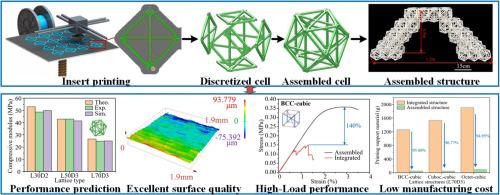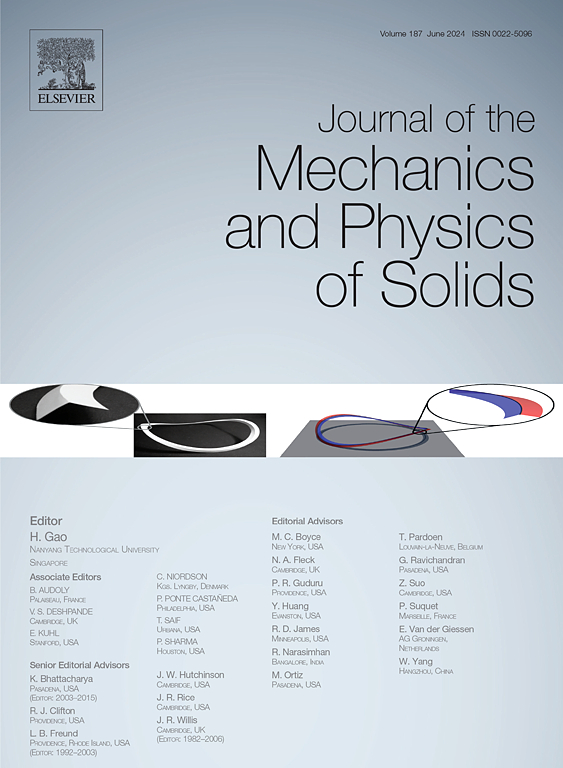Mechanical properties of modular assembled composite lattice architecture
IF 5
2区 工程技术
Q2 MATERIALS SCIENCE, MULTIDISCIPLINARY
引用次数: 0
Abstract
The layer-by-layer additive manufacturing approach results in the 3D printed composite lattice structure fails to exploit fiber reinforcement, thereby resulting in inferior mechanical qualities. To address this challenge, this study proposes a novel approach leveraging composite fused filament fabrication (FFF) printing to design modular assembled composite lattice structures. Initially, three high-performance lattice structures were transformed into discrete 2D components and assembled into 3D lattice structures. Subsequently, the mechanical properties of these structures were comprehensively assessed using theoretical, experimental, and finite element analysis methods. Finally, the comparison between the assembled structures and integrated printed lattice structures in terms of surface quality, mechanical properties, and manufacturability revealed significant advantages. The theoretical and finite element analyses accurately predicted the mechanical properties of the lattice structures. The lattice structures that were assembled in a modular way displayed an impressive 74% improvement in surface finish. Additionally, they showed peak strength increases of 140%, 27%, and 26%, respectively, for the mentioned types of topology. The energy absorption also increased significantly by 510.83%, 44.18%, and 30.24%. Furthermore, these assembled structures required less printing support materials, enhancing their manufacturability and cost-effectiveness. This new method of designing modular space structures goes beyond the limitations imposed by equipment by using high-performance topology. It allows for the construction of large-scale, lightweight space structures that offer excellent performance. This study explores innovative opportunities in the field of space manufacturing, offering potential implications for the development of lunar habitats, space telescopes, and space power stations.

模块化组装复合材料晶格结构的机械特性
逐层增材制造方法导致三维打印的复合材料晶格结构无法利用纤维加固,从而导致机械性能较差。为了应对这一挑战,本研究提出了一种利用复合材料熔融长丝制造(FFF)打印技术设计模块化组装复合材料晶格结构的新方法。首先,将三种高性能晶格结构转化为离散的二维组件,并组装成三维晶格结构。随后,使用理论、实验和有限元分析方法对这些结构的机械性能进行了全面评估。最后,在表面质量、机械性能和可制造性方面,对组装结构和集成打印晶格结构进行了比较,结果显示两者具有显著优势。理论和有限元分析准确预测了晶格结构的机械性能。以模块化方式组装的晶格结构在表面光洁度方面提高了 74%,令人印象深刻。此外,上述拓扑类型的峰值强度分别提高了 140%、27% 和 26%。能量吸收也显著增加了 510.83%、44.18% 和 30.24%。此外,这些组装结构所需的印刷辅助材料更少,从而提高了其可制造性和成本效益。这种设计模块化空间结构的新方法通过使用高性能拓扑结构,超越了设备的限制。它允许建造性能卓越的大型轻质空间结构。本研究探讨了空间制造领域的创新机会,为开发月球栖息地、空间望远镜和空间发电站提供了潜在的影响。
本文章由计算机程序翻译,如有差异,请以英文原文为准。
求助全文
约1分钟内获得全文
求助全文
来源期刊
CiteScore
9.80
自引率
9.40%
发文量
276
审稿时长
52 days
期刊介绍:
The aim of Journal of The Mechanics and Physics of Solids is to publish research of the highest quality and of lasting significance on the mechanics of solids. The scope is broad, from fundamental concepts in mechanics to the analysis of novel phenomena and applications. Solids are interpreted broadly to include both hard and soft materials as well as natural and synthetic structures. The approach can be theoretical, experimental or computational.This research activity sits within engineering science and the allied areas of applied mathematics, materials science, bio-mechanics, applied physics, and geophysics.
The Journal was founded in 1952 by Rodney Hill, who was its Editor-in-Chief until 1968. The topics of interest to the Journal evolve with developments in the subject but its basic ethos remains the same: to publish research of the highest quality relating to the mechanics of solids. Thus, emphasis is placed on the development of fundamental concepts of mechanics and novel applications of these concepts based on theoretical, experimental or computational approaches, drawing upon the various branches of engineering science and the allied areas within applied mathematics, materials science, structural engineering, applied physics, and geophysics.
The main purpose of the Journal is to foster scientific understanding of the processes of deformation and mechanical failure of all solid materials, both technological and natural, and the connections between these processes and their underlying physical mechanisms. In this sense, the content of the Journal should reflect the current state of the discipline in analysis, experimental observation, and numerical simulation. In the interest of achieving this goal, authors are encouraged to consider the significance of their contributions for the field of mechanics and the implications of their results, in addition to describing the details of their work.

 求助内容:
求助内容: 应助结果提醒方式:
应助结果提醒方式:


